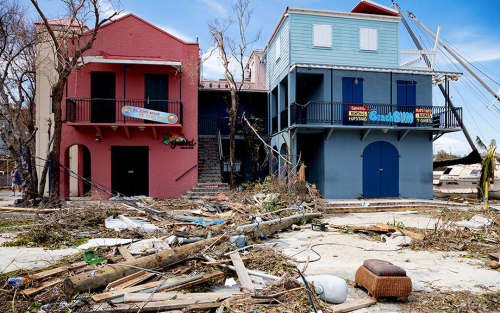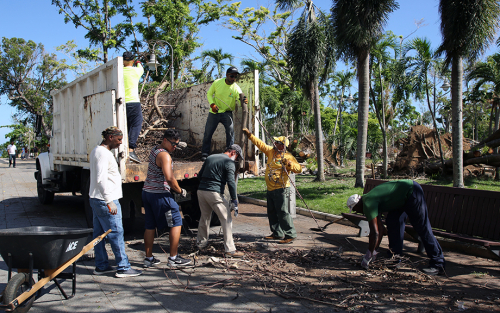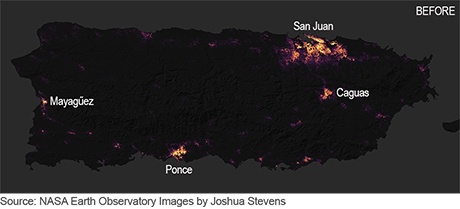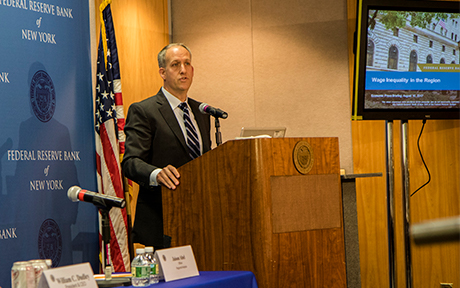U.S. Virgin Islands’ Economy Hit Hard by Irma and Maria

In the nine months that have passed since Hurricanes Irma and Maria ravaged the Caribbean, much interest has been focused on Puerto Rico and its roughly 3.3 million American citizens, who weathered the largest blackout in U.S. history. However, far less attention has been paid to the U.S. Virgin Islands, even though St. Thomas, St. Croix, St. John, and a number of smaller islands suffered comparable devastation. This is partly attributable to their much smaller population: the U.S. Virgin Islands (“Virgin Islands”) is home to roughly 105,000 people—1/30th Puerto Rico’s population. Even so, this territory is also part of the United States and the New York Fed’s district. In this post, we examine roughly six months of economic and related data on the Virgin Islands’ economy to better ascertain the extent of disruption and subsequent recovery from the devastation of Hurricanes Irma and Maria.
Why New York City Subway Delays Don’t Affect All Riders Equally

The state of the New York City subway system has worsened considerably over the past few years. As a consequence of rising ridership and decaying infrastructure, the network is plagued by delays and frequently fails to deliver New Yorkers to their destinations on time. While these delays are a headache for anyone who depends on the subway to get around, they do not affect all riders in the same way. In this post, we explain why subway delays disproportionately affect low-income New Yorkers. We show that wealthier commuters who rely on the subway are less likely to experience extensive issues on their commutes.
Just Released: Puerto Rico and the U.S. Virgin Islands after Hurricanes Irma and Maria

An examination of the fallout from Hurricanes Irma and Maria on the economies of Puerto Rico and the U.S. Virgin Islands was the focus of an economic press briefing today at the New York Fed. Both U.S. territories were suffering from significant economic downturns and fiscal stress well before the storms hit in September 2017, raising concerns about their paths to recovery.
Just Released: Very Favorable Business Climate Indicated in February Business Leaders Survey
The region’s services sector continues to experience solid growth, according to the New York Fed’s February Business Leaders Survey. The survey’s business climate index reached a record high, and the activity, employment, and capital spending indexes were all fairly steady at high levels, indicating continued expansion. Firms were increasingly optimistic about future business conditions, and strong gains in employment were expected in the months ahead. Notably, price pressures picked up, with the prices paid index advancing to a level not seen since 2014, and the prices received measure reaching its highest mark in six years.
Just Released: Great Recession’s Impact Lingers in Hardest‑Hit Regions

The New York Fed’s Center for Microeconomic Data today released our Quarterly Report on Household Debt and Credit for the fourth quarter of 2017. Along with this report, we have posted an update of state-level data on balances and delinquencies for 2017. Overall aggregate debt balances increased again, with growth in all types of balances except for home equity lines of credit. In our post on the first quarter of 2017 we reported that overall balances had surpassed their peak set in the third quarter of 2008—the result of a slow but steady climb from several years of sharp deleveraging during the Great Recession.
Beginning to Gauge Maria’s Effect on Puerto Rico’s Economy

Just two weeks after most of Puerto Rico dodged the proverbial bullet, missing the brunt of Hurricane Irma, the island was devastated by Maria—one of the ten strongest Atlantic hurricanes on record. Making landfall on September 20, 2017, the storm caused not only massive physical destruction and tragic loss of life but also widespread and persistent power outages, shortages of potable (and even nonpotable) running water, and disruptions to telecommunications and travel, among other issues. With the storm boosting costs and disrupting activity, the short-term economic impact is clearly significant. But an even greater concern is that the adverse short-term effects of the storm, overlaid on an already shrinking economy, may evolve into long-term adverse effects. In this post, we focus on the magnitude, duration, breadth and nature of the economic disruptions, as measured mostly by employment.
How Is Online Shopping Affecting Retail Employment?
Just Released: Economic Press Briefing Focuses on Regional Wage Inequality

The New York-Northern New Jersey region is home to some of the most and least unequal places in the nation, based on research presented today at our economic press briefing examining wage inequality in the region. Wage inequality—meaning the disparity in earnings between workers—has increased significantly in the United States since the early 1980s, though some places have much more wage inequality than others. Fairfield, Conn., for example, ranks as the most unequal metropolitan area in the country, and the New York–Northern New Jersey metropolitan area ranks in the top ten. On the other hand, most of the metropolitan areas in upstate New York are among the least unequal places in the country.
Just Released: June Regional Business Surveys Paint a Mixed Picture

Yesterday’s June Empire State Manufacturing Survey pointed to a significant increase in regional manufacturing activity. However, our parallel survey for the region’s service sector, the June Business Leaders Survey, released today, paints a somewhat dreary picture of regional service-sector activity. These two surveys, taken together, suggest that economic conditions in the New York-Northern New Jersey region are mixed.
















 RSS Feed
RSS Feed Follow Liberty Street Economics
Follow Liberty Street Economics